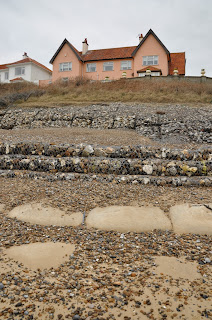It is freezing and bleak on the beach today. I find huge numbers of plastic cups scattered on the beach and tideline: 167 in total. I will do a press release about the cups to draw attention to the issue. (Result: front page and double page spread in the East Anglian Daily Times). There are also many sanitary towels (14) washed up on the tide. The rubbish attaches itself to the barricade like a line of bunting and a sanitary towel is ensnared in the wire.
A ship and numerous tugs are unusually close to the shore - laying cables for Sizewell (windfarms) perhaps?
A purple balloon wafts in strangely on the tide as we walk back. A haunting fuzzy golden light hangs over Aldeburgh in the distance.
low tide: 08.50 hrs 0.4m; high tide 15.04 hrs 2.5m
time of arrival: 14.02 hrs
weather: cloudy, wind E 14mph, temperature 5cmarine litter: large quantities, especially sanitary towels and an exceptional number of plastic cups.
Press release:
A tide of plastic cups
Suffolk artist Fran
Crowe is no stranger to plastics on the beach - over the last 6 years she has
collected many thousands of pieces of plastic rubbish off our local beaches,
making huge art installations with what she finds. But even she was surprised
by what she found on a recent walk by the sea.
Says Fran, “I was
walking and collecting at Thorpeness last week and was amazed by the number of
pieces of plastic cups floating in on the tide. In a short walk I collected
over 50 pieces. But worse still, I went back a couple of days later to the same
place and managed to find an incredible 167 pieces of plastic cups on just a
small stretch of beach! The North Sea increasingly seems to be a large soup of
rubbish and when conditions are right it all just rolls in on the tide...”
Unfortunately plastic
cups, along with other plastic litter, are not an unusual sight on our
beautiful coast. The UN Environment Programme estimated in 2006 that there are
on average over 46000 pieces of plastic litter floating in every square mile of
sea and the North Sea certainly seems to have its fair share!
Moreover, plastics use
precious oil resources (some sources estimate that 9% of the world’s oil is used
to make plastics each year) and can cause huge problems in the environment,
especially our seas, where they can take decades to break down into ever
smaller fragments that continue to pollute our seas indefinitely, perhaps even
ending up in the food chain and the food on our plates.
“It’s such a pity that
some takeaways and cafes are still using plastic cups”, Fran comments, “when
there are good paper alternatives. It’s not just plastic bags we should be
reducing our use of but all
disposable plastics. We use plastic cups for just a few minutes and yet they
will remain in the environment for years.”
As Fran put it on a
recent artwork: “Plastics, like diamonds, are forever...”
As if to prove the
point, on the same walk Fran found a tag from a lobster pot in Newfoundland
dating from 1989 (scarcely weathered by its many years in the sea) that had
finally ended its 2500 mile journey washed up on a Suffolk beach!
To see more of Fran’s
walks and collecting, visit her blog A Year at the Edge ayearattheedge.blogspot.com and
her website www.flyintheface.com



































No comments:
Post a Comment